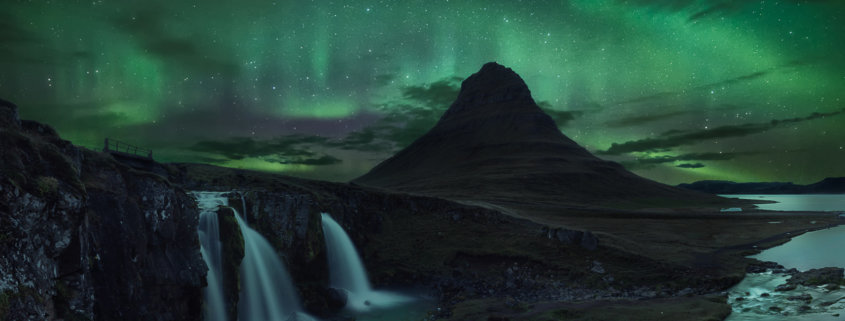Night Photography Guide for capturing Northern Lights
The northern lights spectacle can be described as none other than incredible. It’s something that everyone should experience once in their life. So, no wonder it is on top of every night photographer bucket list. While the beautiful, waving glow in the northern lights may be a sight for sore eyes, trying to capture it on your camera is a different story altogether, and can prove to be quite the challenge… especially for those who don’t have much experience in night photography.
Here’s some highly effective night photography tips that you can use to help capture that beautiful phenomena of northern lights on your camera…
Location and Logistic
- Only countries located towards the north and south pole have the aurora in their skies. So if you go north, the choices are Norway, Iceland, Greenland, Alaska, Canada, and Russia. If you go south, your choices are Tasmania, New Zealand, Patagonia, or Antarctica.
- While the Aurora occurs all year round, you must visit one of these countries at a time of year that has a considerable amount darkness hours. Many of these countries are not dark at all in the summer. So the shoulder season or winter is best for the night sky.
- The sun has an 11-year solar cycle in which it migrates between high sunspot activity to very little. You must go during the years when it’s in the more active period of the cycle to dramatically increase your chance of getting a great aurora show. For more information, visit this wikipedia article.
Photography Equipment
- A camera capable of using manual mode; preferably a DSLR or mirrorless camera.
- A lens that is quite wide and fast; preferably one that is capable of opening up to an aperture of f/2 or wider (f/1.8 or f/1.4 is even better). Also, wider is generally better but not 100% necessary.
- A solid tripod that is capable of holding your camera completely still for many seconds.
- A remote shutter release (although a two-second timer on your camera also works).
Camera Settings for Norther Lights
- You must use manual exposure mode on your DSLR or Mirroless camera. There is no way out of this. For those night photographers who not comfortable with shooting in a manual mode, I highly recommend that you practice before heading before planning your trip.
- Open the aperture up as wide as possible (this means the smallest number your lens can go to). The ideal is f/2 or below, with f/1.8 and f/1.4 being best. Some lens performance may degrade at very wide open aperture. I would highly recommend that you know the limitation of your lenses before choosing the right aperture to capture the northern lights.
- The ISO depends on how powerful the aurora is. If it’s a weak aurora, you must use an ISO upwards of 1600 and possibly all the way to 6400. Be prepared for some serious de-noise work in post processing for this. For a strong aurora, you’ll only need to use an ISO of 1600.
- The shutter speed also depends on the activity for the night. For a weak aurora, you need to leave your shutter speed open from anywhere between 10 and 20 seconds. With a really strong aurora, you only need to use a 1/2 second shutter speed to 6 seconds. The shorter the shutter speed, the more character you can capture in the individual light beams. You have to continually dance between getting the correct exposure and a characteristic aurora. This is why strong auroras are always easier to photograph as you can have the best of both worlds.
Focus Settings and More
Focusing can be quite difficult at night, so you’ll need to pick a distant object and focus on it manually. Using focus-assist on your LCD screen can help, as it magnifies the live image. So, choose a distant mountain towards the horizon or a bright start in the night sky. Rotate your focus ring all the way to infinity, then back it up a couple of millimeters, as “infinity” is generally not in focus on most lenses. Take a test shot and zoom in on the image to ensure it’s sharp.
When you’re done creating exposures for the aurora, do an extra-long exposure at a slightly narrower aperture and lower ISO, for the foreground. This gives you a higher quality and cleaner image when you combine them later in Photoshop.
Feel free to share your own experiences below.













Clint,
Fantastic shots. Thanks for the white balance info above. Can you give any more Lightroom post tips? Noise reduction tips? How much dehaze & clarity have you been using? Thanks.
Hello Drew,
Check out our Illuminated & Working with Light Tutorial on Visual Wilderness. Illuminated Tutorial has on location case study to capture Northern Lights while Working with Light Tutorial shows you how to process the photo.
You didn’t mention white balance setting in your article. Advice?
Hi Carl,
Generally I do something between 3300-4600. But that depends on the atmosphere. Often if there are glowing lights in the background from a neighboring town, it’ll warm up the image a bit, so would tend towards the cool side of that range. But perhaps in very dark conditions, heading towards the warm side of that range would be good. Good thing about shooting in RAW is that you can adjust this after in your favorite raw converter.
Cheers,
Clint
You can also check out Working with Light Tutorial that has a real life case study that shows you how to process the Northern Light images.